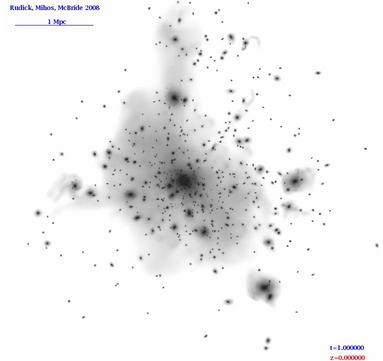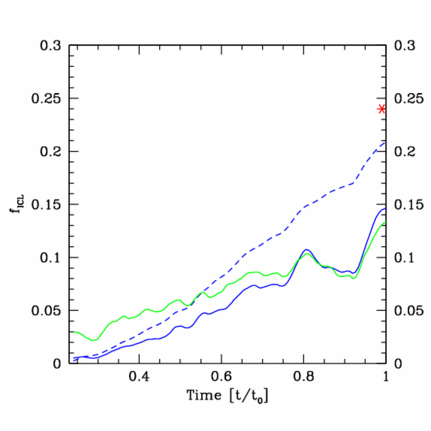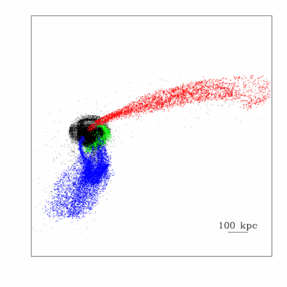|
This work has been made possible by funding from the National Science Foundation, and has utilized the computing resources of the TeraGrid network and the CWRU ITS High Performance Cluster. I am working with Chris Mihos, using numerical simulations to study low surface brightness, diffuse light in galaxy clusters, which is known as intra-cluster light or just ICL. Cameron McBride was responsible for a lot of the early work that got this project started. Our simulation technique involves evolving a high resolution cluster within a lower resolution cosmological volume (sometimes referred to as a "zoom"-type simulation). This allows us to simulate the accretion history of the cluster over cosmological timescales, while still putting all our computing power into the cluster itself (our largest simulations use ~500k CPU-hours). At right is an image of the luminous component of one of our clusters at z=0. The ICL is the huge halo of low-surface brightness material which permeates the cluster, plus lots of tidal streams, plumes, and tails which are visible. Click on the image to watch a movie of the cluster's evolution. | 
(click for movie) |
|
Quantity of ICL
The first obvious question to try to answer with these simulations is just how much ICL do we find in our clusters? The answer to that depends very much on precisely how you define ICL. Theorists' favorite definition is stars which have become unbound to any particular galaxy in the cluster, or they can measure the 3-d particle densities. Observers using surface brightness maps cannot measure the binding energy of individual stars, and must therefore use either surface brightness limits or galaxy model fitting to define the ICL. At right is a plot measuring the fraction of the cluster's luminosity which is in the ICL (the ICL fraction) in one of our simulated clusters, using four different definitions, as a function of time. There are lots of things we can learn from these plots, but the two headlines are:
|

|
|
Streams of ICL
One of the themes that keeps coming up in our ICL work is that the ICL seems to be generated predominantly from close, strong interactions between galaxies and groups of galaxies within the cluster. These types of interactions generally produce distinct tidal streams which are then dissolved as they mix in the cluster potential. We see lots of these streams in our simulations (especially at earlier times) and also in our observations of the Virgo cluster. In order to study these streams, we developed an algorithm which is able to detect such streams in the simulations (its basically a friends-of-friends-type clustering algorithm that finds groups of ICL particles correlated in phase space). The image at right shows examples of some of these streams: in black are a small group of galaxies which have just finished merging, and the three different colors are all different ICL streams that the algorithm identified. The bottom right right plot shows some of our basic findings. First, at z=0, over 40% of the ICL was initially generated in the form of a stream. This is really a lower limit due to our definition, so we can safely say that most of the ICL forms from these types of close galactic encounters which generate tidal streams. However, at z=0 only 6% of the ICL is currently in stream form; i.e. most of the streams have dissolved. Because the fraction of the ICL currently found in a stream decreases with time after t~0.5 (half the age of the universe, or z~1), we can use this as another crude estimate of a cluster's dynamical age where dynamically older clusters should have a smaller fraction of their ICL in streams than dynamically younger clusters. |

 |
Papers
- The Formation and Evolution of Intracluster Light. Rudick, C.S., Mihos, J.C., & McBride, C. 2006, ApJ, 648, 936. astro-ph
- Tidal Streams of Intracluster Light. Rudick, C.S., Mihos, J.C., Frey, L.H., & McBride, C.K. 2009, ApJ, 699, 1518. astro-ph
- The Quantity of Intracluster Light: Comparing Theoretical and Observational Measurement Techniques using Simulated Clusters. Rudick, C.S., Mihos, J.C., & McBride, C.K., ApJ, 732, 48. astro-ph
Homepage
Last modified: Tue Aug 21 17:04:49 CEST 2012